Permafrost Soil Moisture Monitoring Using Multi-Temporal TerraSAR-X Data in Beiluhe of Northern Tibet, China
Abstract
:1. Introduction
2. Test Site and Datasets
2.1. Test Site
2.2. Ground Measurements
2.3. SAR Datasets
3. Soil Moisture Retrieval
3.1. Time-Series Radar Backscattering Coefficients
3.2. Separation of Different Landcover Types
3.3. Estimation of Soil Moisture
4. Experimental Results and Validation
4.1. Time-Series Approach Results
4.2. Time-Series Soil Moisture Mapping
5. Discussions
5.1. The Effect of Soil Roughness
5.2. The Effect of Vegetation
6. Conclusions
- (1)
- It is found that the time-series of of alpine meadow areas show seasonal variations, with −20 dB in winter and −10 dB in summer, whereas the of alpine desert areas do not show seasonal variations.
- (2)
- The term derived from two images acquired in winter season with different incidence angles can be used to eliminate the soil roughness variable when retrieving SM from radar signal. Moreover, the term could be used to separate the alpine meadow and desert area.
- (3)
- In Beiluhe area, time-series SM maps are retrieved from ° of TerraSAR-X with RMSE of 0.062 cm3/cm3 in comparison with in-situ measurements. These results validate the feasibility of the proposed methodology.
- (4)
- The retrieved time-series SM maps point out the spatial and temporal variation patterns in the test site. The SM variations are correlated with thawing and freezing cycles, and with those of the alpine meadow that show more regular seasonal variations.
Author Contributions
Funding
Acknowledgments
Conflicts of Interest
References
- Yang, K.; Ye, B.; Zhou, D.; Wu, B.; Foken, T.; Qin, J.; Zhou, Z. Response of hydrological cycle to recent climate changes in the Tibetan Plateau. Clim. Chang. 2011, 109, 517–534. [Google Scholar] [CrossRef]
- Yang, K.; Qin, J.; Zhao, L.; Chen, Y.; Tang, W.; Han, M.; Lin, C. A multiscale soil moisture and freeze-thaw monitoring network on the third pole. Bull. Am. Meteorol. Soc. 2013, 94, 1907–1916. [Google Scholar] [CrossRef]
- Su, Z.; Wen, J.; Dente, L.; van der Velde, R.; Wang, L.; Ma, Y.; Yang, K.; Hu, Z. The Tibetan Plateau observatory of plateau scale soil moisture and soil temperature (Tibet-Obs) for quantifying uncertainties in coarse resolution satellite and model products. Hydrol. Earth Syst. Sci. 2011, 15, 2303–2316. [Google Scholar] [CrossRef] [Green Version]
- Jackson, T.J. Measuring surface soil moisture using passive microwave remote sensing. Hydrol. Process. 1993, 7, 139–152. [Google Scholar] [CrossRef]
- Paloscia, S.; Macelloni, G.; Santi, E.; Koike, T. A multifrequency algorithm for the retrieval of soil moisture on a large scale using microwave data from SMMR and SSM/I satellites. IEEE Trans. Geosci. Remote Sens. 2001, 39, 79–93. [Google Scholar] [CrossRef]
- Shi, J.C.; Wang, J.; Hsu, A.Y.; O’Neill, P.E.; Engman, E.T. Estimation of bare surface soil moisture and surface roughness parameter using L-band SAR image data. IEEE Trans. Geosci. Remote Sens. 1997, 35, 1254–1266. [Google Scholar]
- Aubert, M.; Baghdadi, N.; Zribi, M.; Ose, K.; Hajj, M.; Vaudour, E.; Sosa, E. Toward an Operational Bare Soil Moisture Mapping Using TerraSAR-X Data Acquired Over Agricultural Areas. IEEE J. Sel. Top. Appl. Earth Obs. Remote Sens. (JSTARS) 2013, 6, 900–916. [Google Scholar] [CrossRef] [Green Version]
- Zhang, X.; Zhao, J.; Sun, Q.; Wang, X.; Guo, Y.; Li, J. Soil moisture retrieval from AMSR-E data in Xinjiang (China): Models and validation. IEEE J. Sel. Top. Appl. Earth Obs. Remote Sens. (JSTARS) 2011, 4, 117–127. [Google Scholar] [CrossRef]
- Baghdadi, N.; Cerdan, O.; Zribi, M.; Auzet, V.; Darboux, F.; ElHajj, M. Operational performance of current synthetic aperture radar sensors in mapping soil surface characteristics in agricultural environments: Application to hydrological and erosion modelling. Hydrol. Process. 2008, 22, 9–20. [Google Scholar] [CrossRef]
- Le Hegarat-Mascle, S.; Zribi, M.; Alem, F.; Weisse, A.; Loumagne, C. Soil moisture estimation from ERS/SAR data: Toward an operational methodology. IEEE Trans. Geosci. Remote Sens. 2002, 40, 2647–2658. [Google Scholar] [CrossRef]
- Balenzano, A.; Mattia, F.; Satalino, G.; Davidson, M.W.J. Dense temporal series of C- and L-band SAR data for soil moisture retrieval over agricultural crops. IEEE J. Sel. Top. Appl. Earth Obs. Remote Sens. (JSTARS) 2011, 4, 439–450. [Google Scholar] [CrossRef]
- Merzouki, A.; McNairn, H.; Pacheco, A. Mapping soil moisture using RADARSAT-2 data and local autocorrelation statistics. IEEE J. Sel. Top. Appl. Earth Obs. Remote Sens. (JSTARS) 2011, 4, 128–137. [Google Scholar] [CrossRef]
- Zribi, M.; Dechambre, M. A new empirical model to retrieve soil moisture and roughness from C-band radar data. Remote Sens. Environ. 2003, 84, 42–52. [Google Scholar] [CrossRef]
- Dobson, M.C.; Ulaby, F.T.; Pierce, L.E. Land-cover classification and estimation of terrain attributes using synthetic aperture radar. Remote Sens. Environ. 1995, 51, 199–214. [Google Scholar] [CrossRef]
- Ulaby, F.T.; Kouyate, F.; Brisco, B.; Williams, T.H.L. Textural infornation in SAR images. IEEE Trans. Geosci. Remote Sens. 1986, GE-24, 235–245. [Google Scholar] [CrossRef]
- Hallikainen, M.T.; Ulaby, F.T.; Dobson, M.C.; El-rayes, M.A.; Wu, L. Microwave Dielectric Behavior of Wet Soil-Part 1: Empirical-Models and Experimental Observations. IEEE Trans. Geosci. Remote Sens. 1985, 23, 25–34. [Google Scholar] [CrossRef]
- Fung, A.K.; Li, Z.; Chen, K.S. Backscattering from a Randomly Rough Dielectric Surface. IEEE Trans. Geosci. Remote Sens. 1992, 30, 356–369. [Google Scholar] [CrossRef]
- Wu, T.D.; Chen, K.S. A Reappraisal of the Validity of the IEM Model for Backscattering from Rough Surfaces. IEEE Trans. Geosci. Remote Sens. 2004, 42, 743–753. [Google Scholar]
- Chen, K.S.; Wu, T.D.; Tsang, L.; Li, Q.; Shi, J.C.; Fung, A.K. Emission of Rough Surfaces Calculated by the Integral Equation Method with Comparison to Three-Dimensional Moment Method Simulations. IEEE Trans. Geosci. Remote Sens. 2003, 41, 90–101. [Google Scholar] [CrossRef]
- Oh, Y. Quantitative Retrieval of Soil Moisture Content and Surface Roughness from Multipolarized Radar Observations of Bare Soil Surfaces. IEEE Trans. Geosci. Remote Sens. 2004, 42, 596–601. [Google Scholar] [CrossRef]
- Dubois, P.C.; van Zyl, J.; Engman, T. Measuring soil moisture with imaging radars. IEEE Trans. Geosci. Remote Sens. 1995, 33, 915–926. [Google Scholar] [CrossRef] [Green Version]
- Rahman, M.M.; Moran, M.S.; Thoma, D.P.; Bryant, R.; Collins, C.D.H.; Jackson, T.; Orr, B.J.; Tischler, M. Mapping Surface Roughness and Soil Moisture Using Multi-Angle Radar Imagery without Ancillary Data. Remote Sens. Environ. 2008, 112, 391–402. [Google Scholar] [CrossRef]
- Oh, Y.; Sarabandi, K.; Ulaby, F.T. An empirical model and an inversion technique for radar scattering from bare soil surfaces. IEEE Trans. Geosci. Remote Sens. 1992, 30, 370–381. [Google Scholar] [CrossRef]
- Oh, Y.; Kay, Y.C. Condition for precise measurement of soil surface roughness. IEEE Trans. Geosci. Remote Sens. 1998, 36, 691–695. [Google Scholar]
- Zribi, M.; Baghdadi, N.; Holah, N.; Fafin, O.; Guérin, C. Evaluation of a rough soil surface description with ASAR-ENVISAT Radar Data. Remote Sens. Environ. 2005, 95, 67–76. [Google Scholar] [CrossRef]
- Baghdadi, N.; Holah, N.; Zribi, M. Soil Moisture Estimation Using Multi-Incidence and Multi-Polarization ASAR Data. Int. J. Remote Sens. 2006, 27, 1907–1920. [Google Scholar] [CrossRef]
- Srivastava, H.S.; Patel, P.; Manchanda, M.; Adiga, S. Use of multi-incidence angle RADARSAT-1 SAR data to incorporate the effect of surface roughness in soil moisture estimation. IEEE Trans. Geosci. Remote Sens. 2003, 41, 1638–1640. [Google Scholar] [CrossRef]
- Hajnsek, I.; Jagdhuber, T.; Schön, H.; Papathanassiou, K.P. Potential of Estimating Soil Moisture under Vegetation Cover by Means of PolSAR. IEEE Trans. Geosci. Remote Sens. 2009, 47, 442–454. [Google Scholar] [CrossRef] [Green Version]
- Paloscia, S.; Macelloni, G.; Pampaloni, P.; Santi, E. The Contribution of Multitemporal SAR Data in Assessing Hydrological Parameters. IEEE Trans. Geosci. Remote Sens. Lett. 2004, 1, 201–205. [Google Scholar] [CrossRef]
- Nolan, M.; Fatland, D.R.; Hinzman, L. DInSAR Measurements of Soil Moisture. IEEE Trans. Geosci. Remote Sens. 2003, 41, 2802–2813. [Google Scholar] [CrossRef]
- Hajnsek, I.; Prats, P. Soil Moisture Estimation in Time with D-InSAR. In Proceedings of the IGARSS 2008, Boston, MA, USA, 7–11 July 2008; pp. 546–549. [Google Scholar]
- De Zan, F.; Parizzi, A.; Prats-Iraola, P.; López-Dekker, P. A SAR Interferometric Model for Soil Moisture. IEEE Trans. Geosci. Remote Sens. 2014, 52, 418–425. [Google Scholar] [CrossRef] [Green Version]
- Sabel, D.; Bartsch, A.; Schlaffer, S.; Klein, J.-P.; Wagner, W. Soil Moisture Mapping in Permafrost Regions-An Outlook to Sentinel-1. In Proceedings of the IGARSS 2012, Munich, Germany, 22–27 July 2012; pp. 1216–1219. [Google Scholar]
- Van der Velde, R.; Su, Z. Dynamics in land-surface conditions on the Tibetan Plateau observed by Advanced Synthetic Aperture Radar (ASAR). Hydrol. Sci. J. 2009, 54, 1079–1093. [Google Scholar] [CrossRef] [Green Version]
- Tang, W.; Kelly, R. Sensitivity of Radarsat-2 Quad Polarimetric and Simulated Compact Polarimetric Parameters to Soil Moisture and Freeze/Thaw State in Southwest Ontario. In Proceedings of the IEEE IGARSS 2014, Quebec City, QC, Canada, 13–18 July 2014; pp. 3232–3235. [Google Scholar]
- Van der Velde, R.; Su, Z.; van Oevelen, P.; Wen, J.; Ma, Y.; Salama, M.S. Soil moisture mapping over the central part of the Tibetan Plateau using a series of ASAR WS images. Remote Sens. Environ. 2012, 120, 175–187. [Google Scholar] [CrossRef]
- Wang, C.; Zhang, H.; Wu, Q.; Zhang, Z.; Xie, L. Monitoring permafrost soil moisture with multi-temporal TerraSAR-X data in northern Tibet. In Proceedings of the IEEE IGARSS 2016, Beijing, China, 10–15 July 2016; pp. 3039–3042. [Google Scholar]
- Aubert, M.; Baghdadi, N.; Zribi, M.; Douaoui, A.; Loumagne, C.; Baup, F.; El Hajje, M.; Garrigues, S. Analysis of TerraSAR-X data sensitivity to bare soil moisture, roughness, composition and soil crust. Remote Sens. Environ. 2011, 115, 1801–1810. [Google Scholar] [CrossRef] [Green Version]
- Wu, Q.; Hou, Y.; Yun, H.; Liu, Y. Changes in active-layer thickness and near-surface permafrost between 2002 and 2012 in alpine ecosystems, Qinghai–Xizang (Tibet) Plateau, China. Glob. Planet. Chang. 2015, 124, 149–155. [Google Scholar] [CrossRef]
- Lee, J.S.; Grunes, M.; Pottier, E.; Ferro-Famil, L. Segmentationof polarimetric SAR images. In Proceedings of the IGARSS, Sydney, Australia, 9–13 July 2001; Volume 1, pp. 414–416. [Google Scholar]



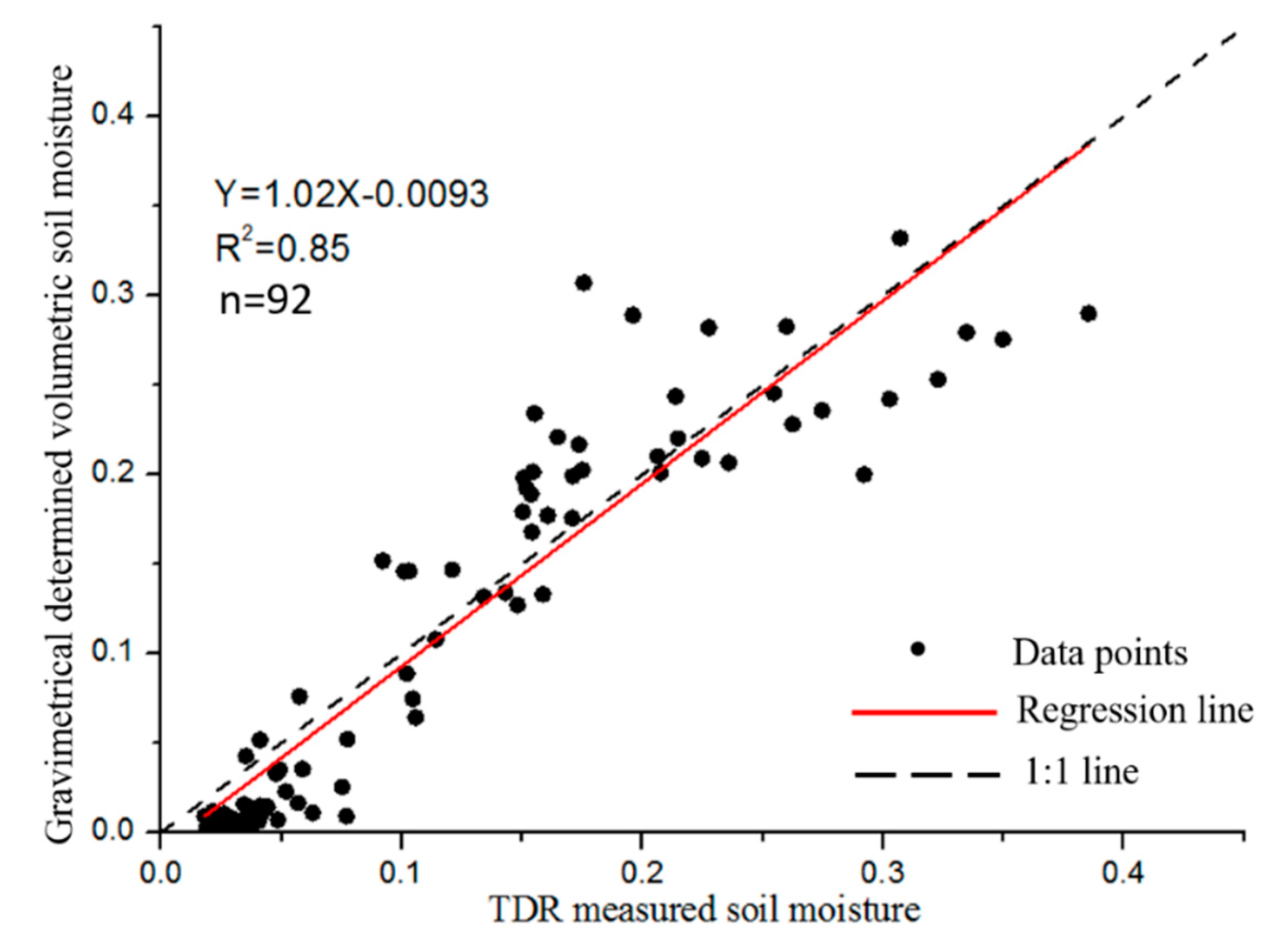
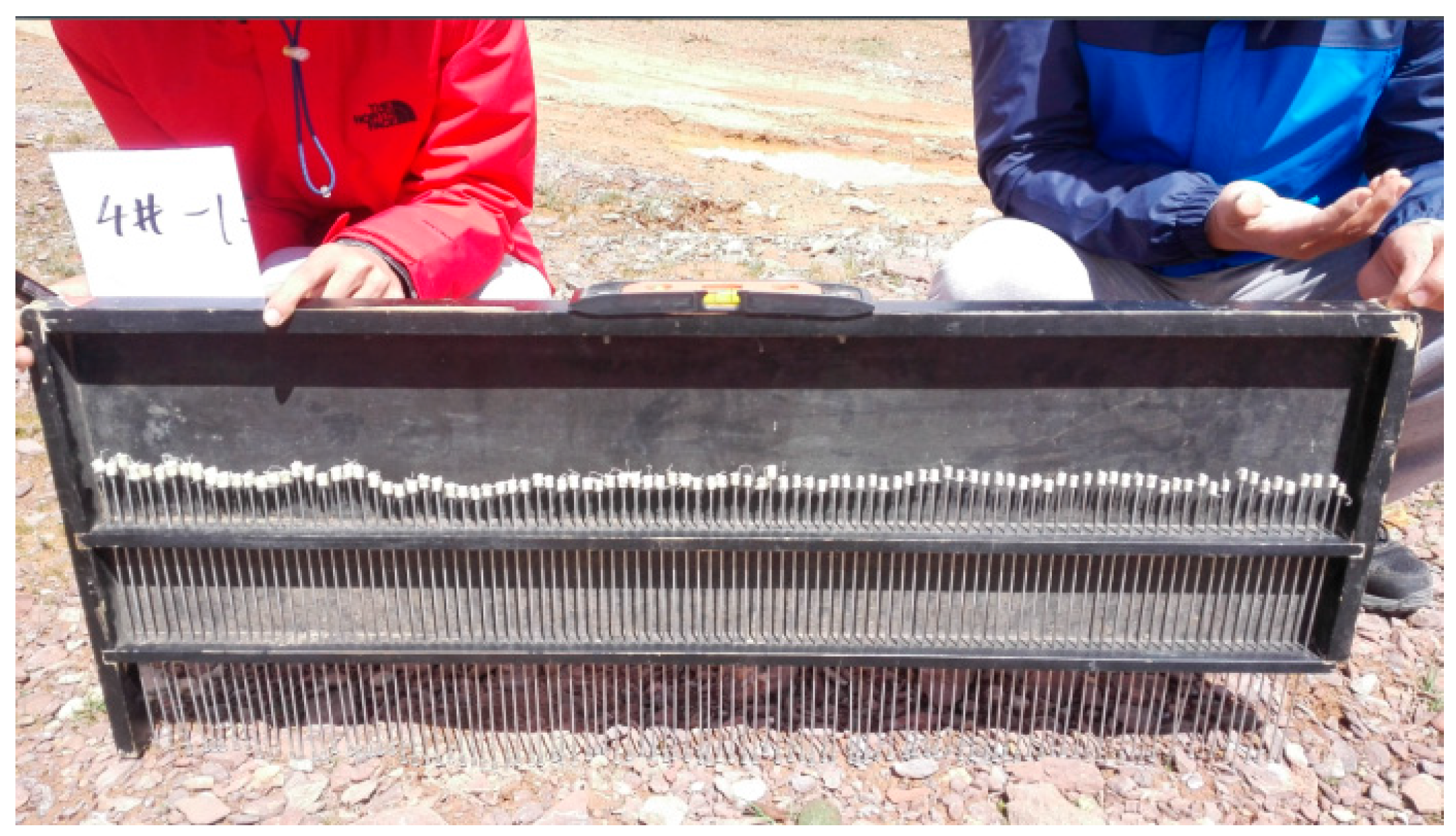

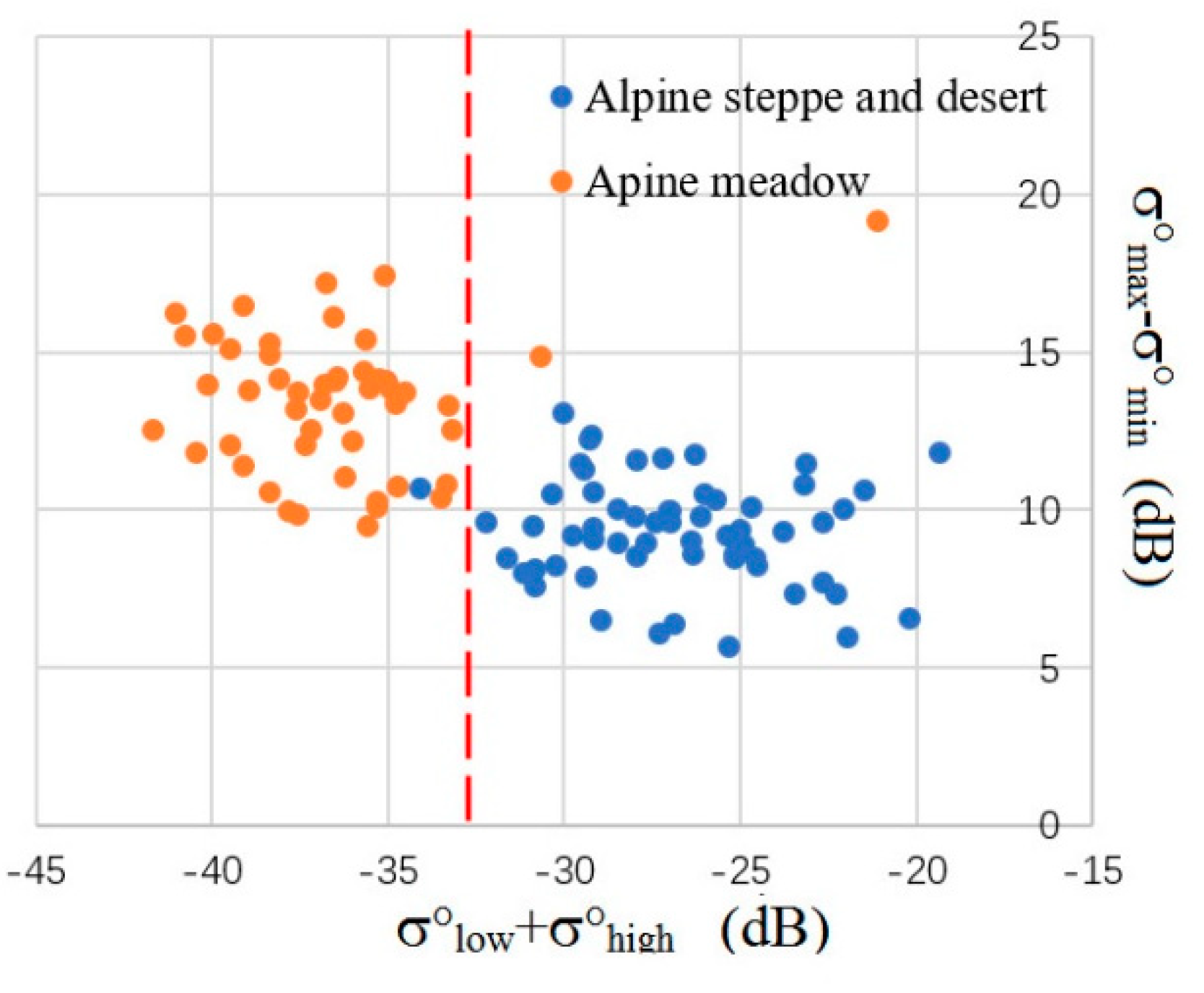

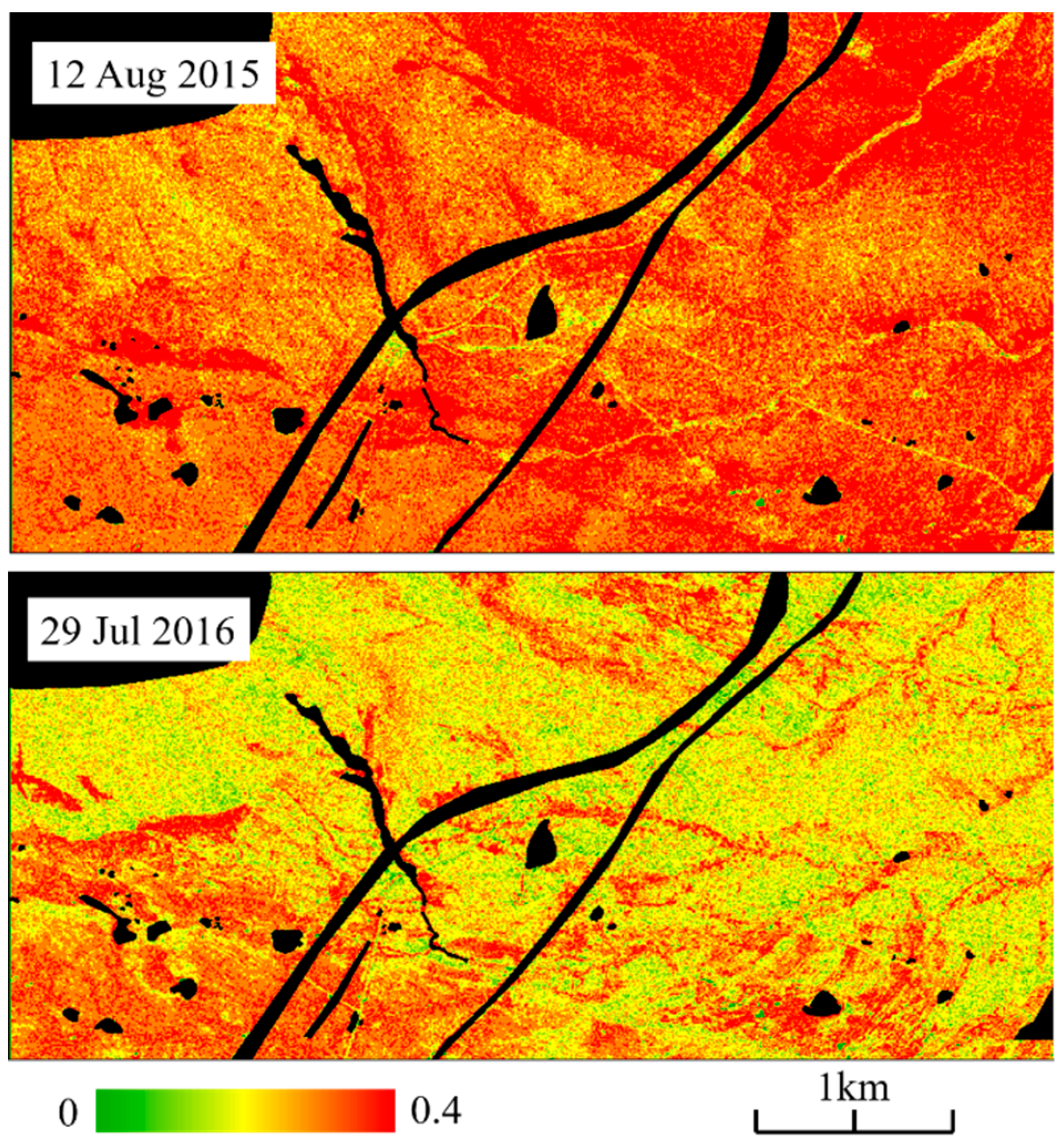
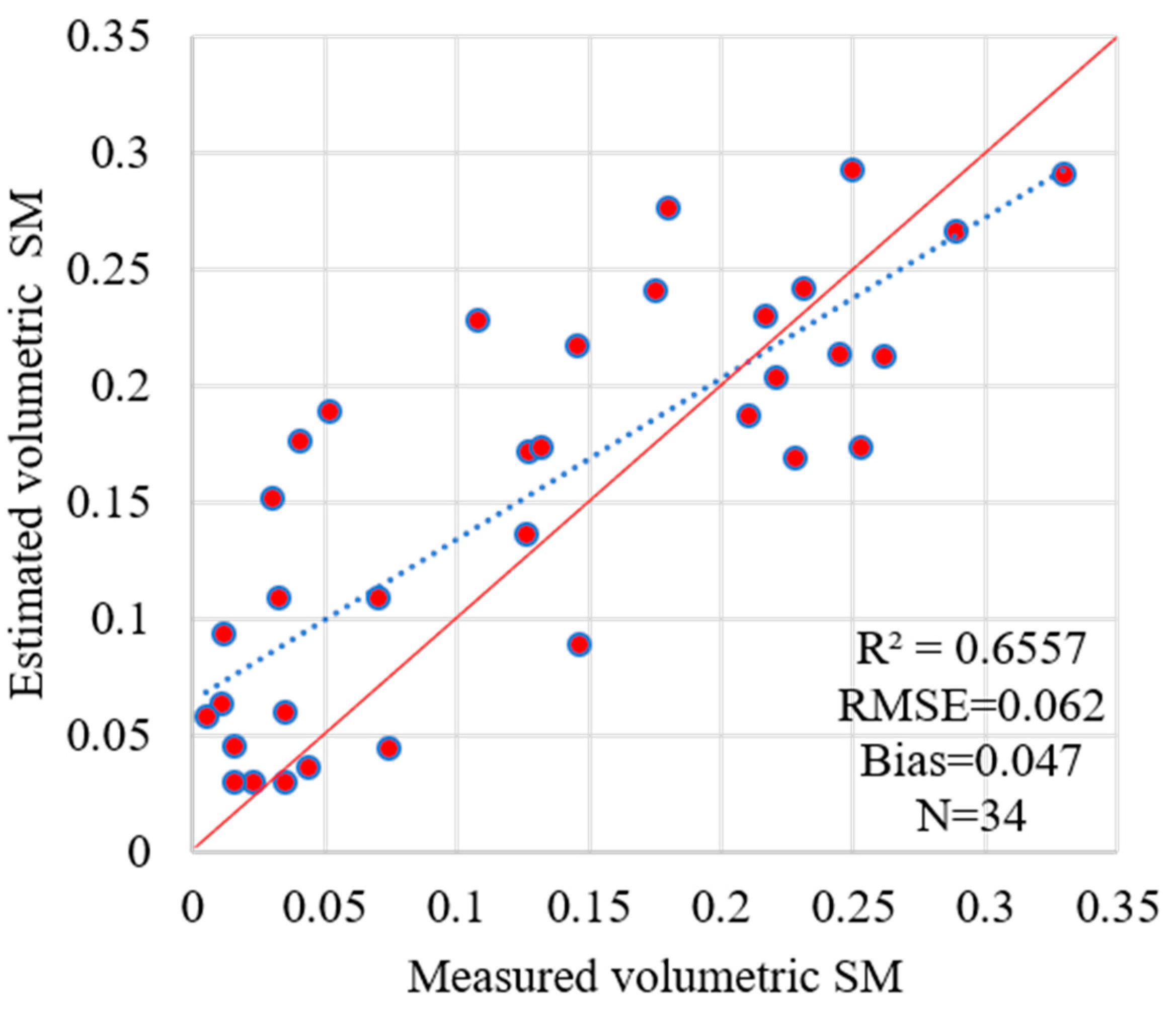
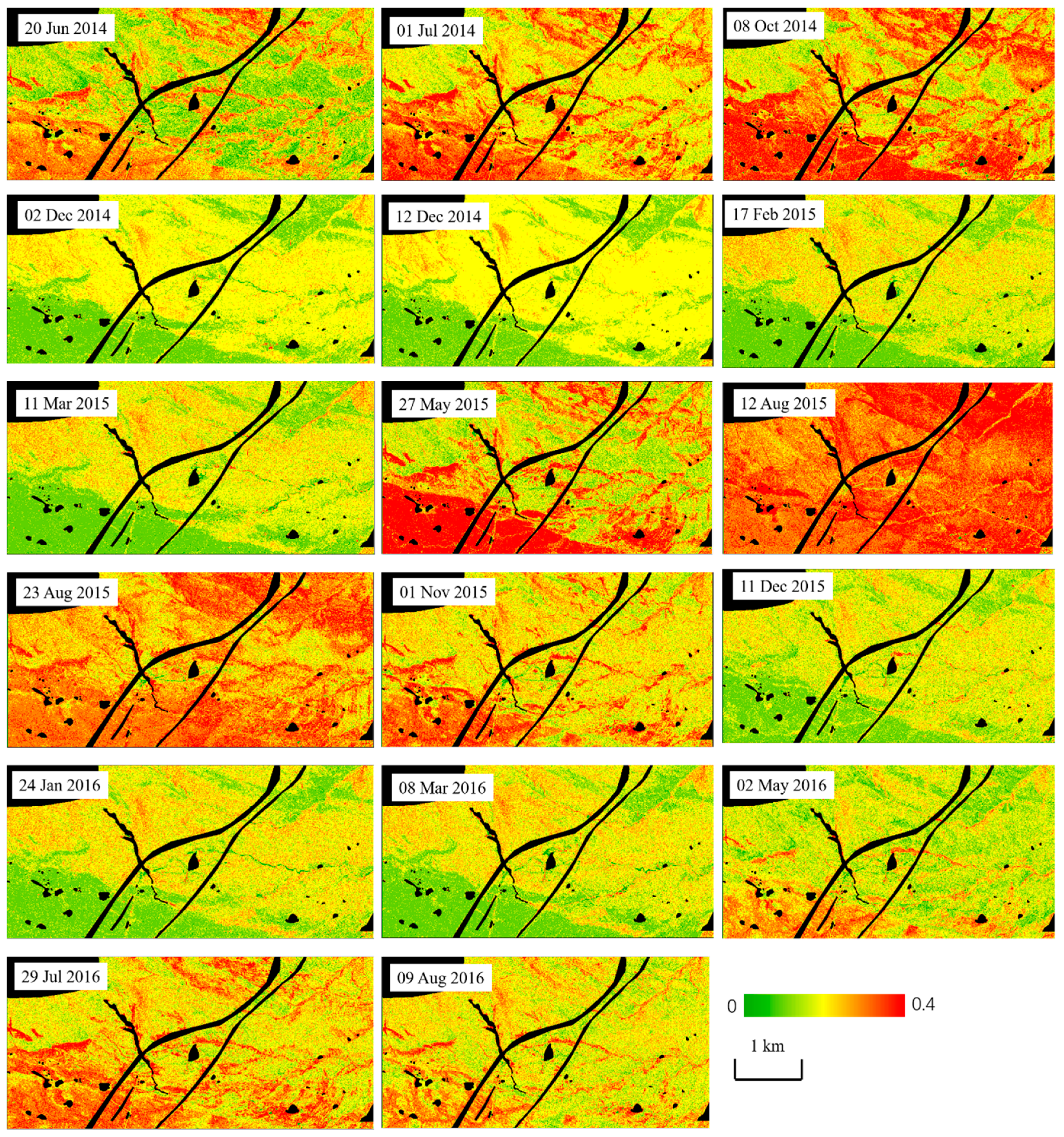
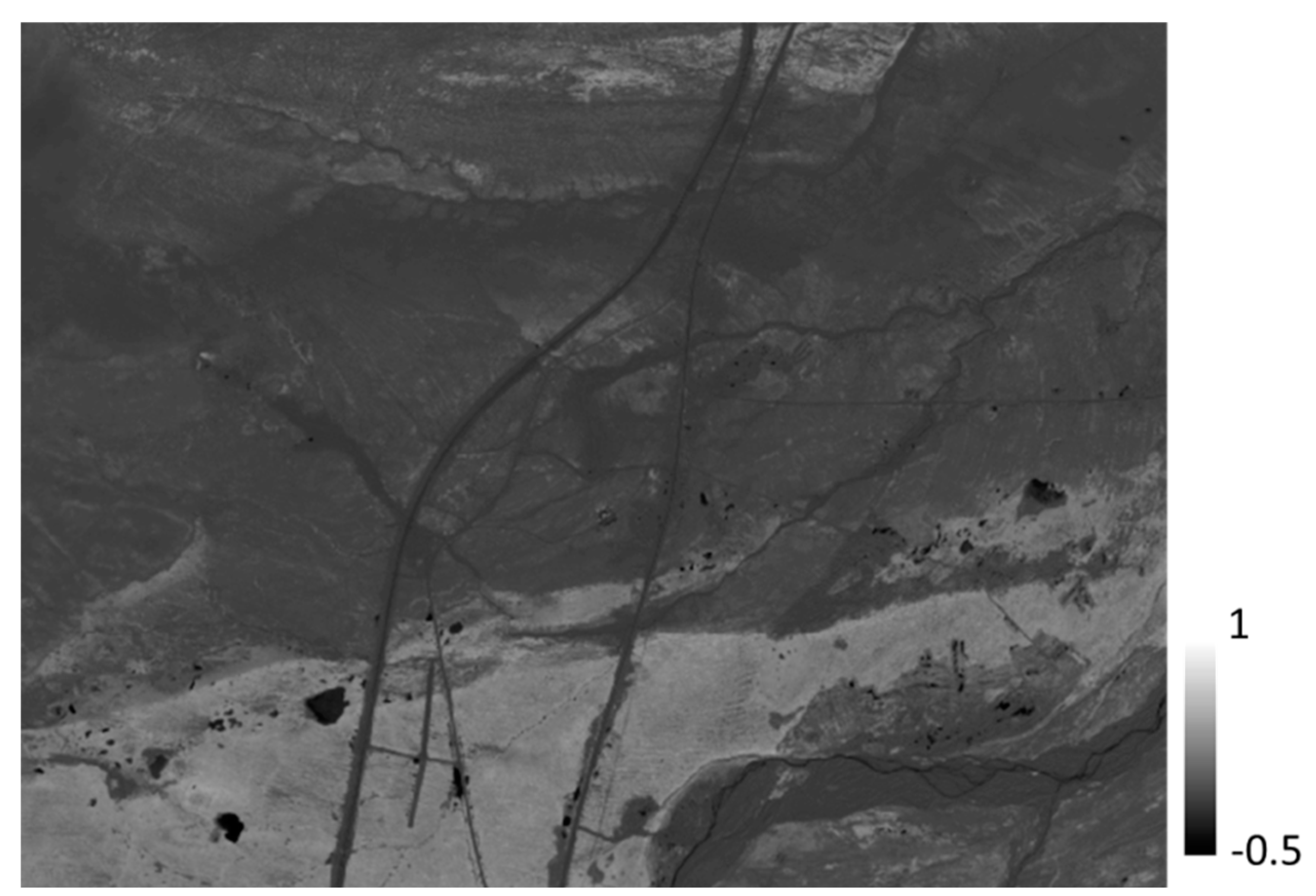
| No. | Acquisition Date (dd/mm/yy) | Incidence Angle (°) | Thawing (T)/Freezing (F) Season | No. | Acquisition Date (dd/mm/yy) | Incidence Angle (°) | Thawing (T)/Freezing (F) Season |
|---|---|---|---|---|---|---|---|
| 1 | 20/06/2014 | 25.429 | T | 12 | 06/10/2015 | 25.429 | T |
| 2 | 01/07/2014 | 25.429 | T | 13 | 01/11/2015 | 25.429 | F |
| 3 | 08/10/2014 | 25.429 | T | 14 | 11/12/2015 | 25.429 | F |
| 4 | 02/12/2014 | 25.429 | F | 15 | 07/01/2016 | 42.299 | F |
| 5 | 13/12/2014 | 25.429 | F | 16 | 24/01/2016 | 25.429 | F |
| 6 | 09/01/2015 | 42.299 | F | 17 | 08/03/2016 | 25.429 | F |
| 7 | 17/02/2015 | 25.429 | F | 18 | 13/03/2016 | 42.299 | F |
| 8 | 11/03/2015 | 25.429 | F | 19 | 02/05/2016 | 25.429 | T |
| 9 | 27/05/2015 | 25.429 | T | 20 | 29/07/2016 | 25.429 | T |
| 10 | 12/08/2015 | 25.429 | T | 21 | 03/08/2016 | 42.299 | T |
| 11 | 23/08/2015 | 25.429 | T | 22 | 09/08/2016 | 25.429 | T |
© 2018 by the authors. Licensee MDPI, Basel, Switzerland. This article is an open access article distributed under the terms and conditions of the Creative Commons Attribution (CC BY) license (http://creativecommons.org/licenses/by/4.0/).
Share and Cite
Wang, C.; Zhang, Z.; Paloscia, S.; Zhang, H.; Wu, F.; Wu, Q. Permafrost Soil Moisture Monitoring Using Multi-Temporal TerraSAR-X Data in Beiluhe of Northern Tibet, China. Remote Sens. 2018, 10, 1577. https://doi.org/10.3390/rs10101577
Wang C, Zhang Z, Paloscia S, Zhang H, Wu F, Wu Q. Permafrost Soil Moisture Monitoring Using Multi-Temporal TerraSAR-X Data in Beiluhe of Northern Tibet, China. Remote Sensing. 2018; 10(10):1577. https://doi.org/10.3390/rs10101577
Chicago/Turabian StyleWang, Chao, Zhengjia Zhang, Simonetta Paloscia, Hong Zhang, Fan Wu, and Qingbai Wu. 2018. "Permafrost Soil Moisture Monitoring Using Multi-Temporal TerraSAR-X Data in Beiluhe of Northern Tibet, China" Remote Sensing 10, no. 10: 1577. https://doi.org/10.3390/rs10101577





